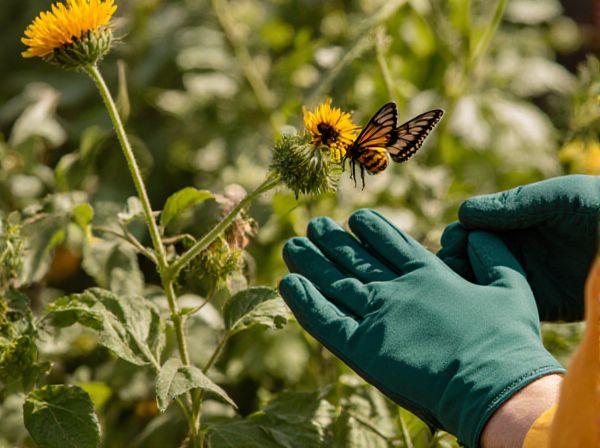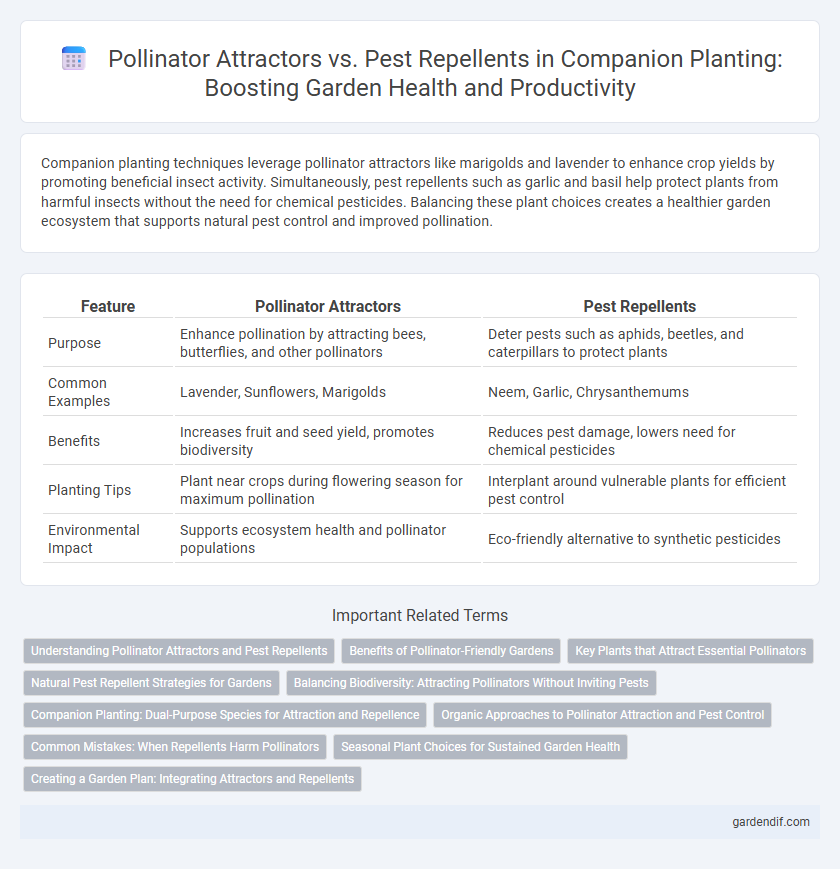
Pollinator attractors vs pest repellents Illustration
Companion planting techniques leverage pollinator attractors like marigolds and lavender to enhance crop yields by promoting beneficial insect activity. Simultaneously, pest repellents such as garlic and basil help protect plants from harmful insects without the need for chemical pesticides. Balancing these plant choices creates a healthier garden ecosystem that supports natural pest control and improved pollination.
Table of Comparison
| Feature | Pollinator Attractors | Pest Repellents |
|---|---|---|
| Purpose | Enhance pollination by attracting bees, butterflies, and other pollinators | Deter pests such as aphids, beetles, and caterpillars to protect plants |
| Common Examples | Lavender, Sunflowers, Marigolds | Neem, Garlic, Chrysanthemums |
| Benefits | Increases fruit and seed yield, promotes biodiversity | Reduces pest damage, lowers need for chemical pesticides |
| Planting Tips | Plant near crops during flowering season for maximum pollination | Interplant around vulnerable plants for efficient pest control |
| Environmental Impact | Supports ecosystem health and pollinator populations | Eco-friendly alternative to synthetic pesticides |
Understanding Pollinator Attractors and Pest Repellents
Pollinator attractors such as flowering plants and herbs enhance crop yields by supporting essential pollination activities from bees, butterflies, and other beneficial insects. Pest repellents, including aromatic plants like marigolds and neem, reduce pest infestations by emitting natural chemicals that deter harmful insects and protect crops. Understanding the distinct roles of pollinator attractors and pest repellents in companion planting helps optimize garden biodiversity and promote sustainable agricultural practices.
Benefits of Pollinator-Friendly Gardens
Pollinator-friendly gardens significantly enhance ecosystem health by attracting bees, butterflies, and other pollinators that improve fruit and vegetable yields through effective pollination. These gardens support biodiversity by providing essential habitats and food sources, increasing plant resilience and crop quality. Promoting pollinator populations also reduces the need for chemical pesticides, creating a healthier environment for plants and beneficial insects alike.
Key Plants that Attract Essential Pollinators
Key plants that attract essential pollinators include lavender, sunflowers, and native wildflowers, which supply abundant nectar and pollen for bees, butterflies, and hummingbirds. These companion plants enhance garden biodiversity by increasing pollination rates, leading to improved fruit set and overall plant health. Selecting pollinator attractors strategically supports sustainable pest management by encouraging beneficial insects and natural predators.
Natural Pest Repellent Strategies for Gardens
Companion plants such as marigolds and nasturtiums act as natural pest repellents by emitting scents that deter harmful insects while attracting beneficial pollinators like bees and butterflies. Employing herbs like basil and rosemary enhances garden health by reducing aphid and whitefly populations without the use of chemicals. Integrating these natural pest repellent strategies supports biodiversity and promotes sustainable garden ecosystems.
Balancing Biodiversity: Attracting Pollinators Without Inviting Pests
Balancing biodiversity in companion planting involves selecting species that attract beneficial pollinators such as bees and butterflies while effectively repelling common pests like aphids and caterpillars. Plants like marigolds and lavender serve as pollinator attractors by providing nectar and pollen, while also emitting natural compounds that deter harmful insects, thereby enhancing ecosystem health and crop yield. Integrating a diverse range of companion species optimizes pest control and pollination, fostering sustainable garden ecosystems.
Companion Planting: Dual-Purpose Species for Attraction and Repellence
Companion planting leverages dual-purpose species that simultaneously attract pollinators and repel pests, optimizing garden health and yield. Plants like marigolds and nasturtiums emit scents that deter harmful insects while drawing beneficial pollinators such as bees and butterflies. This dual functionality enhances biodiversity, reduces the need for chemical interventions, and supports sustainable cultivation practices.
Organic Approaches to Pollinator Attraction and Pest Control
Organic pollinator attractors such as native wildflowers, herbs like lavender and thyme, and companion plants including marigolds enhance biodiversity and increase beneficial insect activity. Pest repellents like neem oil, garlic sprays, and insectary plants, including nasturtiums and chives, provide natural defense mechanisms without disrupting pollinator populations. Incorporating organic companion planting strategies optimizes crop pollination while maintaining effective pest control in sustainable gardening.
Common Mistakes: When Repellents Harm Pollinators
Applying broad-spectrum pest repellents indiscriminately often harms beneficial pollinators like bees and butterflies by disrupting their foraging behavior and reducing their population. Common mistakes include using repellents during peak pollinator activity hours and targeting flowering plants that serve as vital nectar sources. Selecting pollinator-friendly repellents and applying them with consideration of pollinator life cycles enhances garden health and biodiversity.
Seasonal Plant Choices for Sustained Garden Health
Seasonal plant choices play a crucial role in sustaining garden health by balancing pollinator attractors and pest repellents. Spring-blooming plants like lavender and borage attract essential pollinators such as bees and butterflies, while marigolds and nasturtiums repel common pests including aphids and nematodes. Incorporating a diverse mix of flowering plants throughout the growing season enhances pollination rates and naturally controls pest populations for a thriving, resilient garden.
Creating a Garden Plan: Integrating Attractors and Repellents
Designing a garden plan that integrates pollinator attractors such as lavender, marigolds, and coneflowers with pest repellents like garlic, neem, and chives enhances ecosystem balance and plant health. Strategic placement of attractors near fruiting plants boosts pollination rates, while repellents positioned around susceptible crops deter common pests like aphids and beetles. This synergy supports biodiversity, improves yield quality, and reduces the need for chemical interventions in sustainable gardening practices.
Pollinator attractors vs pest repellents Infographic

 gardendif.com
gardendif.com